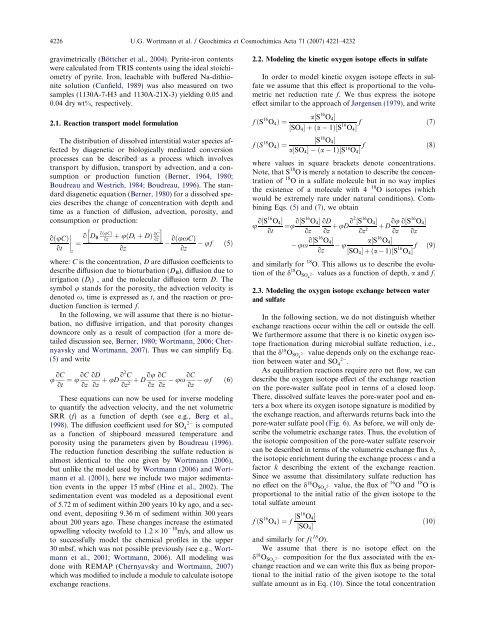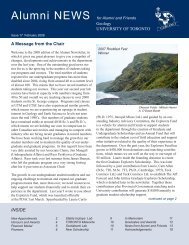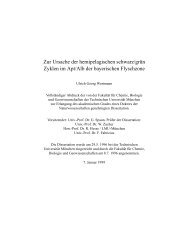Oxygen isotope biogeochemistry of pore water sulfate in the deep ...
Oxygen isotope biogeochemistry of pore water sulfate in the deep ...
Oxygen isotope biogeochemistry of pore water sulfate in the deep ...
- No tags were found...
Create successful ePaper yourself
Turn your PDF publications into a flip-book with our unique Google optimized e-Paper software.
4226 U.G. Wortmann et al. / Geochimica et Cosmochimica Acta 71 (2007) 4221–4232gravimetrically (Böttcher et al., 2004). Pyrite-iron contentswere calculated from TRIS contents us<strong>in</strong>g <strong>the</strong> ideal stoichiometry<strong>of</strong> pyrite. Iron, leachable with buffered Na-dithionitesolution (Canfield, 1989) was also measured on twosamples (1130A-7-H3 and 1130A-21X-3) yield<strong>in</strong>g 0.05 and0.04 dry wt%, respectively.2.1. Reaction transport model formulationThe distribution <strong>of</strong> dissolved <strong>in</strong>terstitial <strong>water</strong> species affectedby diagenetic or biologically mediated conversionprocesses can be described as a process which <strong>in</strong>volvestransport by diffusion, transport by advection, and a consumptionor production function (Berner, 1964, 1980;Boudreau and Westrich, 1984; Boudreau, 1996). The standarddiagenetic equation (Berner, 1980) for a dissolved speciesdescribes <strong>the</strong> change <strong>of</strong> concentration with depth andtime as a function <strong>of</strong> diffusion, advection, porosity, andconsumption or production:oðuCÞot ¼zhoðuCÞo D B ozþ uðD i þ DÞ oCozozioðuxCÞozwhere: C is <strong>the</strong> concentration, D are diffusion coefficients todescribe diffusion due to bioturbation (D B ), diffusion due toirrigation (D i ) , and <strong>the</strong> molecular diffusion term D. Thesymbol u stands for <strong>the</strong> porosity, <strong>the</strong> advection velocity isdenoted x, time is expressed as t, and <strong>the</strong> reaction or productionfunction is termed f.In <strong>the</strong> follow<strong>in</strong>g, we will assume that <strong>the</strong>re is no bioturbation,no diffusive irrigation, and that porosity changesdowncore only as a result <strong>of</strong> compaction (for a more detaileddiscussion see, Berner, 1980; Wortmann, 2006; Chernyavskyand Wortmann, 2007). Thus we can simplify Eq.(5) and writeu oCot ¼ u oC oDoz oz þ uD o2 Coz þ D ou oC2 oz ozux oCozThese equations can now be used for <strong>in</strong>verse model<strong>in</strong>gto quantify <strong>the</strong> advection velocity, and <strong>the</strong> net volumetricSRR (f) as a function <strong>of</strong> depth (see e.g., Berg et al.,1998). The diffusion coefficient used for SO 42is computedas a function <strong>of</strong> shipboard measured temperature andporosity us<strong>in</strong>g <strong>the</strong> parameters given by Boudreau (1996).The reduction function describ<strong>in</strong>g <strong>the</strong> <strong>sulfate</strong> reduction isalmost identical to <strong>the</strong> one given by Wortmann (2006),but unlike <strong>the</strong> model used by Wortmann (2006) and Wortmannet al. (2001), here we <strong>in</strong>clude two major sedimentationevents <strong>in</strong> <strong>the</strong> upper 15 mbsf (H<strong>in</strong>e et al., 2002). Thesedimentation event was modeled as a depositional event<strong>of</strong> 5.72 m <strong>of</strong> sediment with<strong>in</strong> 200 years 10 ky ago, and a secondevent, deposit<strong>in</strong>g 9.36 m <strong>of</strong> sediment with<strong>in</strong> 300 yearsabout 200 years ago. These changes <strong>in</strong>crease <strong>the</strong> estimatedupwell<strong>in</strong>g velocity tw<strong>of</strong>old to 1.2 · 10 10 m/s, and allow usto successfully model <strong>the</strong> chemical pr<strong>of</strong>iles <strong>in</strong> <strong>the</strong> upper30 mbsf, which was not possible previously (see e.g., Wortmannet al., 2001; Wortmann, 2006). All model<strong>in</strong>g wasdone with REMAP (Chernyavsky and Wortmann, 2007)which was modified to <strong>in</strong>clude a module to calculate <strong>isotope</strong>exchange reactions.ufufð5Þð6Þ2.2. Model<strong>in</strong>g <strong>the</strong> k<strong>in</strong>etic oxygen <strong>isotope</strong> effects <strong>in</strong> <strong>sulfate</strong>In order to model k<strong>in</strong>etic oxygen <strong>isotope</strong> effects <strong>in</strong> <strong>sulfate</strong>we assume that this effect is proportional to <strong>the</strong> volumetricnet reduction rate f. We thus express <strong>the</strong> <strong>isotope</strong>effect similar to <strong>the</strong> approach <strong>of</strong> Jørgensen (1979), and writef ðS 16 O 4 Þ¼a½S 16 O 4 Š½SO 4 Šþða 1Þ½S 16 O 4 Š f ð7Þf ðS 18 ½S 18 O 4 ŠO 4 Þ¼a½SO 4 Š ða 1Þ½S 18 O 4 Š f ð8Þwhere values <strong>in</strong> square brackets denote concentrations.Note, that S 18 O is merely a notation to describe <strong>the</strong> concentration<strong>of</strong> 18 O <strong>in</strong> a <strong>sulfate</strong> molecule but <strong>in</strong> no way implies<strong>the</strong> existence <strong>of</strong> a molecule with 4 18 O <strong>isotope</strong>s (whichwould be extremely rare under natural conditions). Comb<strong>in</strong><strong>in</strong>gEqs. (5) and (7), we obta<strong>in</strong>u o½S16 O 4 Šot¼u o½S16 O 4 Š oDozux o½S16 O 4 Šozoz þ ½S 16 O 4 ŠuDo2 þ D ou o½S 16 O 4 Šoz 2 oz oza½S 16 O 4 Šu½SO 4 Šþða 1Þ½S 16 O 4 Š f ð9Þand similarly for 18 O. This allows us to describe <strong>the</strong> evolution<strong>of</strong> <strong>the</strong> d 18 O SO4 2 values as a function <strong>of</strong> depth, a and f.2.3. Model<strong>in</strong>g <strong>the</strong> oxygen <strong>isotope</strong> exchange between <strong>water</strong>and <strong>sulfate</strong>In <strong>the</strong> follow<strong>in</strong>g section, we do not dist<strong>in</strong>guish whe<strong>the</strong>rexchange reactions occur with<strong>in</strong> <strong>the</strong> cell or outside <strong>the</strong> cell.We fur<strong>the</strong>rmore assume that <strong>the</strong>re is no k<strong>in</strong>etic oxygen <strong>isotope</strong>fractionation dur<strong>in</strong>g microbial <strong>sulfate</strong> reduction, i.e.,that <strong>the</strong> d 18 O SO4 2 value depends only on <strong>the</strong> exchange reactionbetween <strong>water</strong> and SO 2 4.As equilibration reactions require zero net flow, we candescribe <strong>the</strong> oxygen <strong>isotope</strong> effect <strong>of</strong> <strong>the</strong> exchange reactionon <strong>the</strong> <strong>pore</strong>-<strong>water</strong> <strong>sulfate</strong> pool <strong>in</strong> terms <strong>of</strong> a closed loop.There, dissolved <strong>sulfate</strong> leaves <strong>the</strong> <strong>pore</strong>-<strong>water</strong> pool and entersa box where its oxygen <strong>isotope</strong> signature is modified by<strong>the</strong> exchange reaction, and afterwards returns back <strong>in</strong>to <strong>the</strong><strong>pore</strong>-<strong>water</strong> <strong>sulfate</strong> pool (Fig. 6). As before, we will only describe<strong>the</strong> volumetric exchange rates. Thus, <strong>the</strong> evolution <strong>of</strong><strong>the</strong> isotopic composition <strong>of</strong> <strong>the</strong> <strong>pore</strong>-<strong>water</strong> <strong>sulfate</strong> reservoircan be described <strong>in</strong> terms <strong>of</strong> <strong>the</strong> volumetric exchange flux b,<strong>the</strong> isotopic enrichment dur<strong>in</strong>g <strong>the</strong> exchange process and afactor k describ<strong>in</strong>g <strong>the</strong> extent <strong>of</strong> <strong>the</strong> exchange reaction.S<strong>in</strong>ce we assume that dissimilatory <strong>sulfate</strong> reduction hasno effect on <strong>the</strong> d 18 O SO4 2 value, <strong>the</strong> flux <strong>of</strong> 16 O and 18 Oisproportional to <strong>the</strong> <strong>in</strong>itial ratio <strong>of</strong> <strong>the</strong> given <strong>isotope</strong> to <strong>the</strong>total <strong>sulfate</strong> amountf ðS 16 O 4 Þ¼f ½S16 O 4 Šð10Þ½SO 4 Šand similarly for f( 18 O).We assume that <strong>the</strong>re is no <strong>isotope</strong> effect on <strong>the</strong>d 18 O SO4 2 composition for <strong>the</strong> flux associated with <strong>the</strong> exchangereaction and we can write this flux as be<strong>in</strong>g proportionalto <strong>the</strong> <strong>in</strong>itial ratio <strong>of</strong> <strong>the</strong> given <strong>isotope</strong> to <strong>the</strong> total<strong>sulfate</strong> amount as <strong>in</strong> Eq. (10). S<strong>in</strong>ce <strong>the</strong> total concentration








